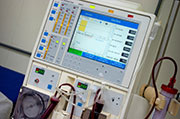- How Daily Prunes Can Influence Cholesterol and Inflammation
- When to Take B12 for Better Absorption and Energy
- Epsom Salts: Health Benefits and Uses
- See What Saffron Can Do for Sleep and Heart Health
- 6 Common Mistakes to Avoid Before Your Physical
- Can Sweating Really Help You Beat a Cold?
- Strengthening Your Relationship: Practical Strategies
- Skip Storing This Everyday Product in the Fridge Door
- Green Tea + B3 Pairing May Boost Brain Health
- Navigating Your Midlife Crisis: Embracing New Possibilities
Study Finds Two Drugs Aren’t Better Than One for Kidney Disease


THURSDAY, Nov. 14Two drugs are not always better than one, a new study indicates.
Combining two blood pressure medications that normally help people with kidney disease that is triggered by diabetes didn’t lead to greater improvement. And using both actually harmed the kidneys, researchers report.
The worse the kidney disease was to start with, the more likely it was that the drug duo caused problems, they added.
The two types of drugs used are called angiotensin-converting-enzyme (ACE) inhibitors and angiotensin-receptor-blockers (ARBs), and they lower blood pressure and help reduce the amount of protein in the urine. Protein in the urine is a sign of kidney damage.
“We thought that in this high-risk group of people, a combination of the two would help. We thought it might slow the progression of their kidney disease,” said study author Dr. Linda Fried, a staff physician in the renal section of the Veterans Affairs Pittsburgh Healthcare System.
“We saw a small, but not statistically significant, benefit in progression. But, we also had serious adverse events. We saw more hospitalizations, people required more treatments. Overall, the risk-benefit ratio just doesn’t support use [of both drugs],” Fried said.
The findings were published in the Nov. 14 issue of the New England Journal of Medicine.
Kidney disease in diabetes is the leading cause of end-stage kidney disease in the United States, according to background information in the study. People with diabetes who have protein in their urine are at a higher risk of developing end-stage kidney disease. Treatment with either an ACE inhibitor or an ARB alone can help delay the progression of diabetic kidney disease, but it’s not enough to stop it, according to the study.
To see if a combination of the two could provide more protection than just one of the drugs alone, Fried and her colleagues had more than 1,400 volunteers take an ARB called losartan at a dose of 100 milligrams (mg), and then randomly assigned them to take either an ACE inhibitor called lisinopril at a dose of 10 mg to 40 mg per day or an inactive placebo.
The average age of the study volunteers was 65, and nearly all were male. Three-quarters were white, and just under one-quarter were black. All had diabetes and significant kidney disease, but were not yet considered to have end-stage kidney disease.
The study began recruiting people in July 2008, but it was stopped in October 2012 due to safety concerns. Those concerns included dangerously high potassium levels and acute kidney injury in those taking both medications.
The researchers found no difference in death rates or heart-related events.
However, the combination therapy did lead to more than double the risk of high potassium levels, which can be deadly; and almost twice the risk of acute kidney injury compared to therapy with just the ARB.
“We thought there might be some people who would not tolerate the therapy, but we did not expect to see that much of a difference in increased risk,” said Fried.
The study authors suggest there seems to be a threshold for how much you can block angiotensin, and after you pass that threshold more harm than benefit occurs.
“The message from this study is an important one. It’s not safe to use both of these drugs together,” said Dr. Robert Provenzano, chair of the department of nephrology at St. John Providence Health System in Detroit.
“When you decrease pressure inside the kidney and decrease blood flow in the kidney too much, the kidney will respond as if in failure, and the ability to get rid of potassium goes down,” he explained.
“If someone is on both classes of the medications, they should bring it up to their doctor. Ask, ‘Is this a safe combination for me?’ There is evidence that this combination is problematic for people with [protein in their urine],” said Provenzano. And, he added, it’s important to bring your medications or a list of medications to each doctor you see.
Although this study was done almost exclusively in men, Fried said it’s likely that the findings would be similar in women.
More information
Learn more about kidney disease and diabetes from the American Diabetes Association.
Source: HealthDay
Copyright © 2026 HealthDay. All rights reserved.










